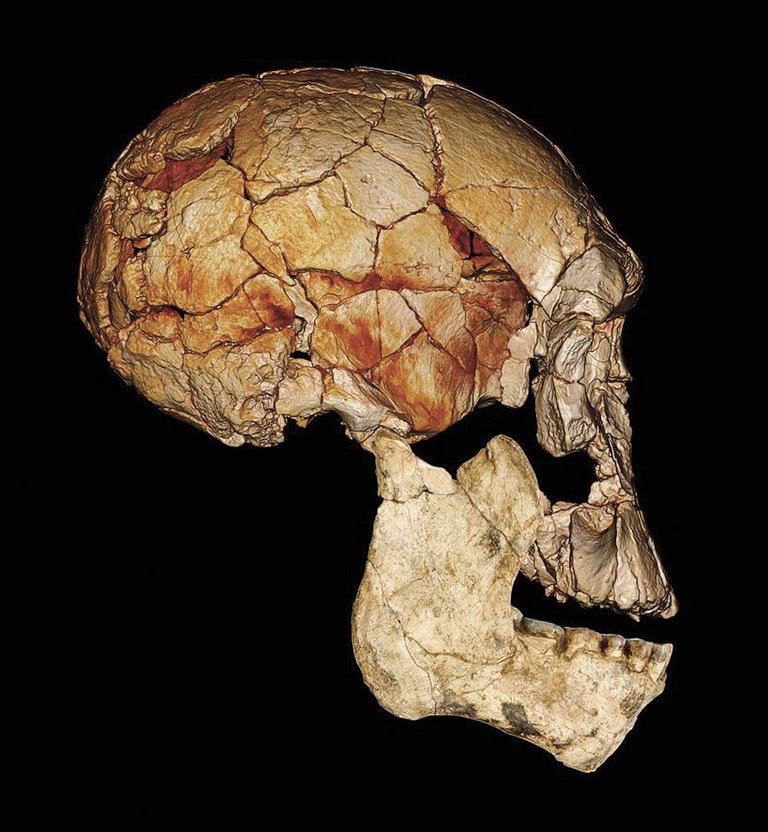The "loneliness" of the human being, the current exception

Last August, the Meave Leakey team presented three new human fossils in the journal Nature. Fossils (a face, a whole jaw and a fragment of jaw) were found in three deposits on the eastern shore of Lake Turkana in Kenya. Geologically they have been dated between 1.78-1.95 million years ago, being the oldest face of this group of fossils. For the authors, these new fossils could belong to the same human species and can be grouped next to the KNM-ER 1470 skull discovered in 1972, whose peculiarity is the flat face. For these scientists, the importance of these new fossils lies in affirming the ancient taxonomic human diversity, that is, that in East Africa different human species coexisted simultaneously.
Richard Leakey introduced KNM-ER 1470 in 1973, Homo sp. He classified it as: This means that, being the fossil of the genus Homo, when compared to the fossils H. erectus and H. habilis, there were many differences. Subsequently, some scientists proposed that the large skull "1470" and the small skulls of H. habilis corresponded to individuals of the same species but of different sexes. This hypothesis has been eliminated with new fossils. The new face is like that of the "1470", but much smaller, so the characteristic face of the "1470" has nothing to do with size, it is not a consequence of allometry. Although in many cases the KNM-ER 1470 was called Homo rudolfensis, in the new article of the Meave Leakey group its designation has been avoided, and what they emphasize is that in East Africa there were two contemporary human species, one similar to the skull "1470", larger brain and flat face, and another smaller prognofuge. Moreover, these researchers classify in another group the oldest human remains, 1.8 million years, found outside Africa (Republic of Georgia): as "early --i.e. initiative-- Homo erectus ".
We can argue that the initial diversity of the homo genus was the result of adaptive radiation, but for the moment we need more fossils and deposits to know the paleobiology, ecology and material culture of these human species. However, the presence of numerous species in our lineage was not, at any given time, the curiosity that occurred at first. However, it seems that the current situation, monospecies, is an exception in our lineage, the genus Homo. In fact, the current "loneliness" is a very "new" situation (from a geological point of view) of 12,000 years. The eruption of the volcano on the island of Flores occurred 12 thousand years ago. This eruption is related to the extinction of small humans Homo floresiensis who inhabited this island. Flores' human fossil had a height of one meter and a brain size of chimpanzee, so it is known as "Hobbit". Although the oldest archaeological remains found on the island are between 800 and 900 thousand years, to date the fossils of this species are between 74 and 12 thousand years. As for their origin, the "Hobbits" could be the result of a process of nanism on the island itself, derived from another human species (perhaps H. erectus, perhaps another).
Human diversity increases over time. For example, 50 thousand years ago our species ( Homo sapiens), after leaving Africa, arrived in Australia. At that time in Europe we could still find the Neanderthals. The Neanderthal (Homo neanderthalensis) has expired as the most famous human species for three fundamental reasons. First, the XIX. It is the first extinct species described in the mid-twentieth century and known to us. Secondly, the causes of the extinction of the Neanderthals are unknown. And, thirdly, what we know today is that the Neanderthals and our species were contemporary in Europe and there have been numerous debates around possible encounters between the two species: to see if they happened and if so it would have been the consequences in the medium and long term. Moreover, the possibility (directly or not) that our species have participated in the disappearance of Neandertal is today an incandescent scientific debate in which an ecological or demographic competition with our species is proposed. It has also been proposed that when the sapiens entered Europe due to climate cooling, the Neanderthals were weakened. Thus, 50 thousand years ago, we can find at least three different human species. On the one hand, perhaps in East Asia Homo erectus had not yet expired, and on the other, molecular paleontology has found the third lineage that is neither sapiens nor Neanderthal: "Denisovanos". Their fossil remains, however, are reduced and, although known genetically, they are still morphologically unknown.
Further back, the situation is the same: In the middle pleistocene we can find at least three different evolutionary human lines. In Europe, our Neanderthal ancestors; in Africa, our pioneers; and in Asia, Homo erectus. With all this we can ensure the exceptionality of the current situation. Thanks to the fossils recovered in the last 50 years, today we know that the evolutionary history of the human being is much more complex (and more interesting), with many evolutionary lines. Therefore, the linear evolution model Homo habilis-H.erectus-H.sapiens is completely surpassed. That is, the “tree” of human evolution is increasingly shaped as a “scrub”, and the presence of a single branch in this “scrub” is, more than a rule, an exception. Today we do not know the fate of all human lines (in that we are), but sometimes after the extinction of some human species we find the same issues that concern us today: ecological competition, demographic pressure, climate change, natural disasters... Paleontology, together with geology and archaeology, offers us tools to better understand the world today. But our task is to take into account what we can learn from the past for the future.
Buletina
Bidali zure helbide elektronikoa eta jaso asteroko buletina zure sarrera-ontzian











